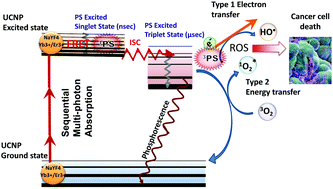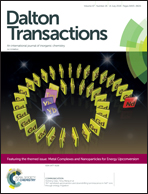Upconversion in photodynamic therapy: plumbing the depths
Abstract
Photodynamic therapy (PDT) involves the combination of non-toxic dyes called photosensitizers (PS) and harmless visible light that interact with ambient oxygen to give reactive oxygen species (ROS) that can damage biomolecules and kill cells. PDT has mostly been developed as a cancer therapy but can also be used as an antimicrobial approach against localized infections. However even the longest wavelength used for exciting PS (in the 700 nm region) has relatively poor tissue penetration, and many PS are much better excited by blue and green light. Therefore upconversion nanoparticles (UCNPs) have been investigated in order to allow deeper-penetrating near-infrared light (980 nm or 810 nm) to be used for PDT. NaYF4 nanoparticles doped with Yb3+ and Er3+ or with Tm3+ and Er3+ have been attached to PS either by covalent conjugation, or by absorption to the coating or shell (used to render the UCNPs biocompatible). Forster resonance energy transfer to the PS then allows NIR light energy to be transduced into ROS leading to cell killing and tumor regression. Some studies have experimentally demonstrated the deep tissue advantage of UCNP-PDT. Recent advances have included dye-sensitized UCNPs and UCNPs coupled to PS, and other potentially synergistic drug molecules or techniques. A variety of bioimaging modalities have also been combined with upconversion PDT. Further studies are necessary to optimize the drug-delivery abilities of the UCNPs, improve the quantum yields, allow intravenous injection and tumor targeting, and ensure lack of toxicity at the required doses before potential clinical applications.

- This article is part of the themed collections: 2018 Frontier and Perspective articles and Metal Complexes and Nanoparticles for Energy Upconversion


 Please wait while we load your content...
Please wait while we load your content...